Abstract
The main goal of this report is to understand and organize the current progress and future steps required to construct and commercialize electric Vertical Takeoff and Landing (eVTOL) taxis as a form of transportation. This report includes Hierarchical Task Analyses (HTAs) of a potential eVTOL taxi service (referred to as Skybs) from the perspectives of both a user and a pilot, and identifies four key areas of discussion: Sound Concerns, Design and Logistics, User Accessibility, and Operational Concerns. These discussions, based on the HTAs and current technology, appear to be key issues that must be resolved in order to create a publicly available eVTOL taxi service.
1. Introduction
The first “drones”, hot air balloons, were created in the 19th century, generating the concept of flight as a form of transportation. Until recently, forms of airborne transportation like planes and drones were used primarily for military purposes, but they have now become commercialized. Today, airplanes are a commercialized industry, and the primary source of transportation over long distances. Commercial drones have also exploded in use, being used today for surveillance, wildfire fighting, agriculture, and many other commercial and industrial purposes. However, in recent years, a new form of airborne technology, combining the drone and the airplane, is being considered by certain companies (Martinez).
As traditional modes of transportation have been around for decades, there is a growing interest in other kinds of transportation. Aerial taxis, also known as flying taxis, are an emerging technology set to transform urban transportation. These vertical take off and landing vehicles are being developed to address traffic congestion in populated cities. According to Maitha Ali Salem Alnuaimi, a GIS manager, air transportation’s market is projected to grow 45.9% from 2022-2040 (Alnuaimi, 2021). Additionally, Alnuaimi states that cities like Dubai want to implement aerial taxis as a mode of transportation. However, with new methods of transportation being introduced to cities around the world, there are rising concerns over the potential environmental impacts. According to the US Department of Transportation, the transportation sector is the largest domestic contributor to climate change, as 33% of the total emissions in the US is from transportation (Transportation, 2022). Additionally, with the lack of research into aerial taxi transportation there may be public concerns regarding its usability and future implications. Therefore, in this paper we will explore the current progress in electrical aerial taxi — those powered by electric or hybrid engines — development, including the technological innovations, regulatory hurdles, and societal implications. With companies like Uber, Volocopter, and Lilium at the forefront, aerial taxis are expected to play a critical role in the future of urban transport. This paper will explore the key factors shaping the development of aerial taxis and assess their potential to revolutionize city travel.
2. Aims and Objectives
Aims:
- To create and commercialize eVTOL taxis in the UK.
Objectives:
- To assess the future of eVTOL taxis from a human-centered design perspective.
- To design HTAs from the perspective of users and pilots of a potential eVTOL taxi service.
- To research current technologies and other forms of transportation that are relevant to the development of eVTOL taxis.
- To analyze the research and HTAs to decide on key issues that are important to the development of eVTOL taxis.
- To further research current and potential future technologies related to the key issues and propose solutions to such issues.
- To create a model of a future eVTOL taxi for reference.
3. Methodology
3.1 Plan a user-centered design strategy
A user-centered design methodology for the report was used, following ISO 9241-210.
3.2 Create HTAs based on the process of using an eVTOL taxi
Hierarchical Task Analysis (HTA) is a user-centered technique that shows a design from the perspective of a user. This breaks down the functionality of designs into their most basic parts, making the design easier to understand and analyze, and is crucial for human-centered design (O’Donoghue, 2023). For this report, HTAs of the usage of a potential eVTOL taxi were created from the perspective of both a user and a pilot, including the process of using the cab and the process of using any relevant applications needed to run an eVTOL taxi operation.
3.3 Literature review
To provide the relevant current key issues involving the development of eVTOL taxis, background research was done on the progress of eVTOL taxis, recent technologies in similar forms of transportation that may be useful to the development of eVTOLs, and relevant user concerns, such as sound, safety, and aircraft laws.
3.4 Analyze the HTAs and literature review and select aspects of the eVTOL to analyze
Upon completion of the HTAs and literature review, the HTAs and literature review were analyzed to look for the main issues currently affecting eVTOL taxis. The literature review was used to understand the current technological deficiencies in the development of eVTOLs, and the HTAs were used to look for potential areas of user concern. Based on this analysis, this report chose to focus on sound concerns, design and logistics, user accessibility, and operational concerns as aspects of the eVTOL to analyze further and provide potential solutions. Solutions to these issues were then proposed using further research.
3.5 Investigate the Use Cases and Potential Applications of eVTOL Technology
After analyzing the HTAs and relevant literature, the implementation of an actual eVTOL was considered. This included modeling an airframe, resolving size and scale issues, determining how a business could implement an aerial taxi service, and what use cases would most benefit from the service. Once the model was made, conclusions could be drawn about where and how the system could operate and in what environments. The further study of these models, if completed, could lead to a viable airframe and logistics system for a business wishing to implement eVTOL operations into its scope.
3.6 Create a Model of a potential eVTOL
After researching and analyzing the user requirements of eVTOLs, we created an exterior of the eVTOL. We also did research on suitable dimensions/lengths to create an accurate design for better contextualization.
4. Results
4.1 HTA Chart
User HTA:
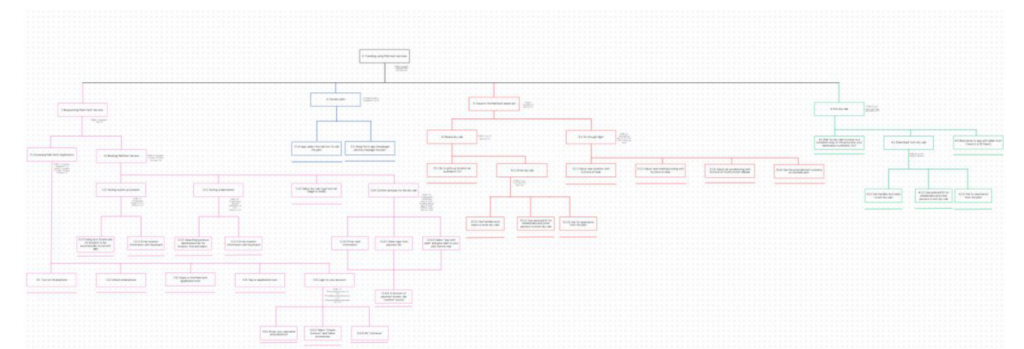
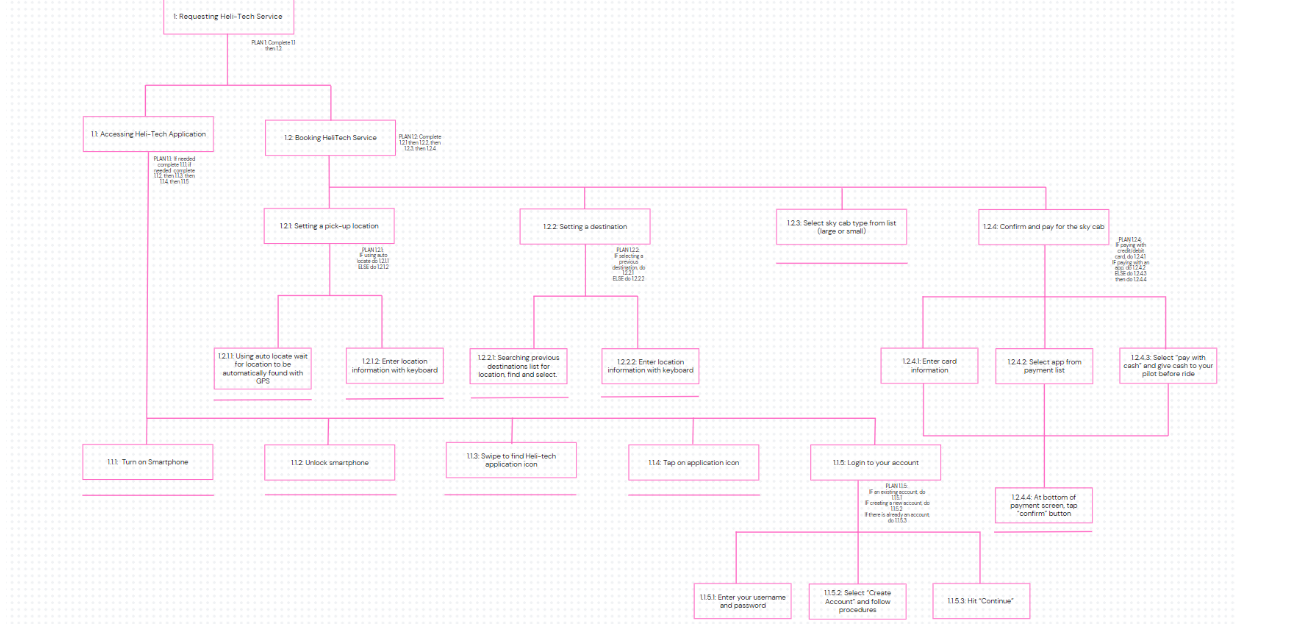
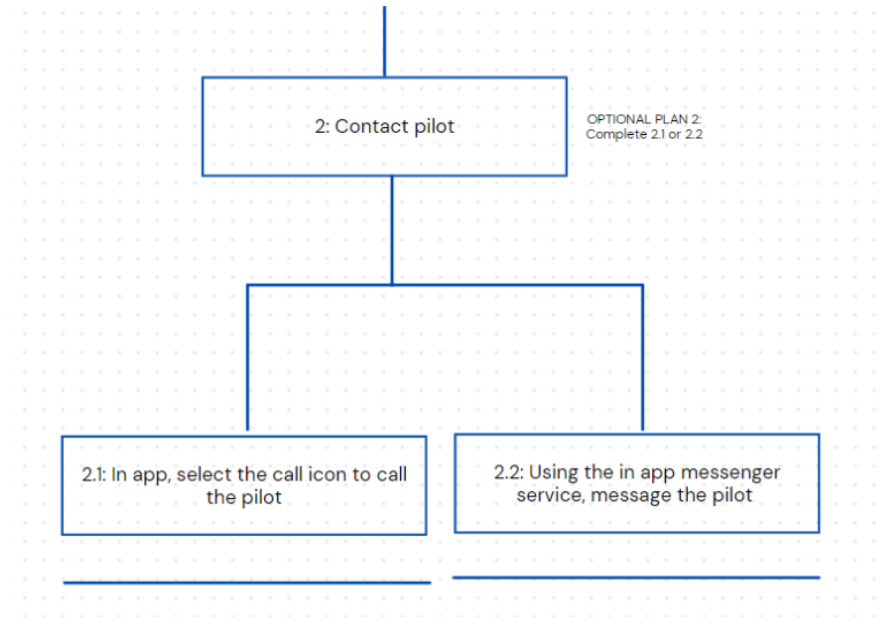
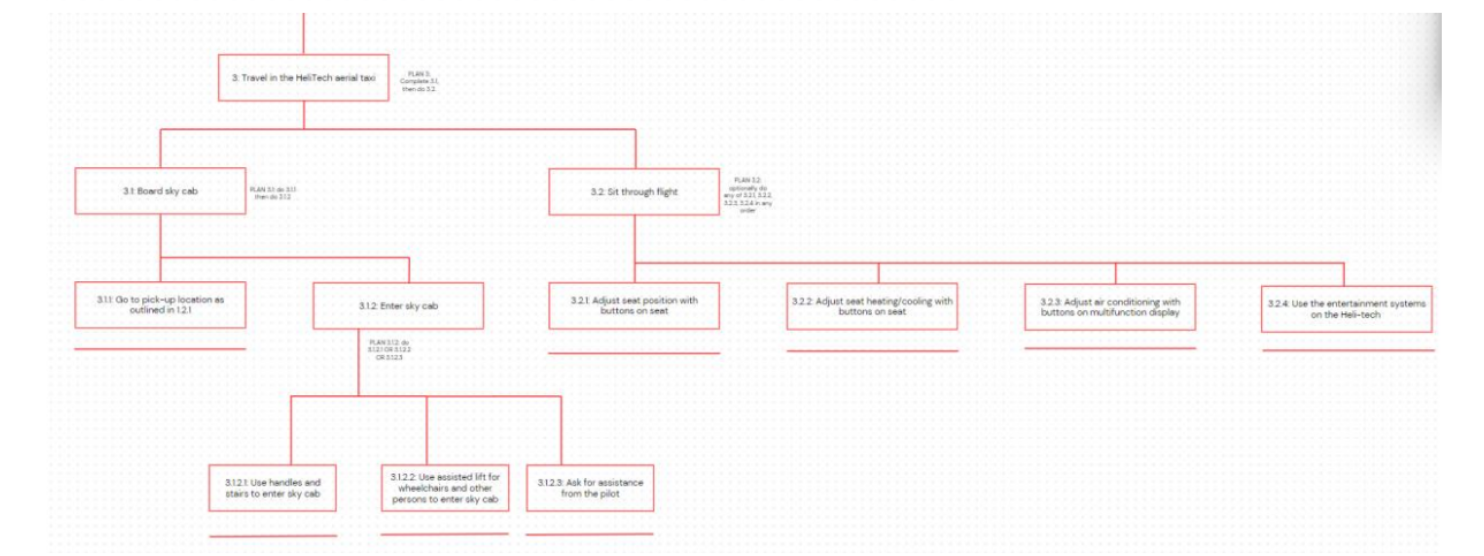
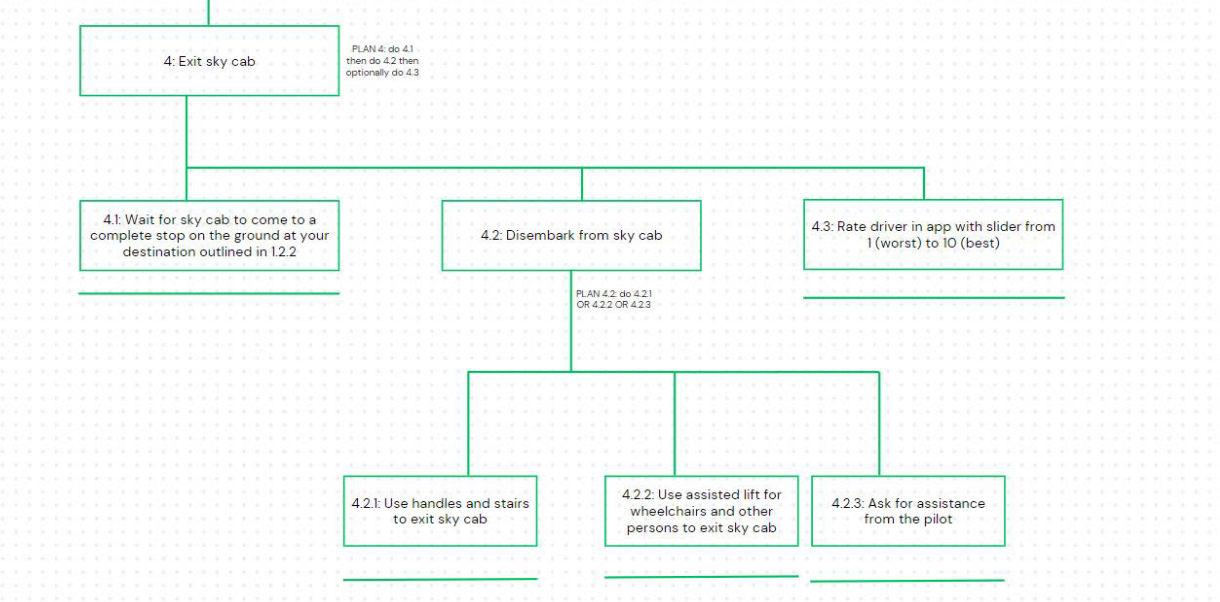
Pilot HTA:





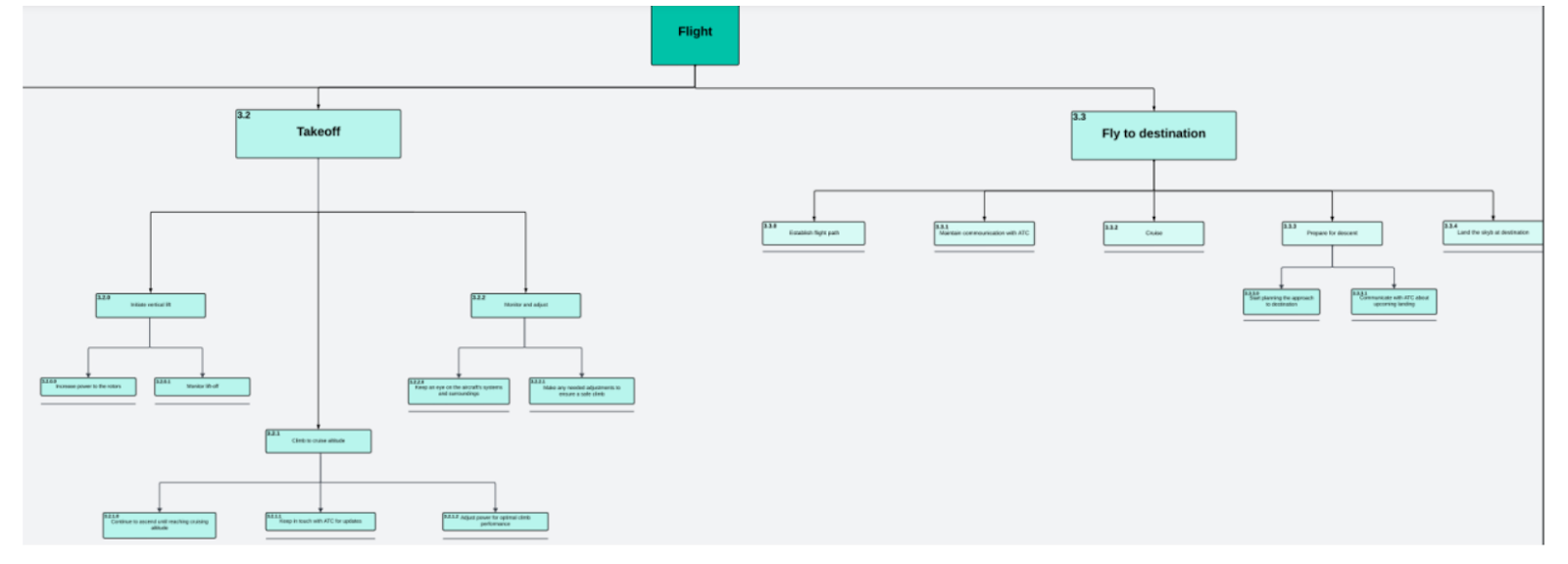

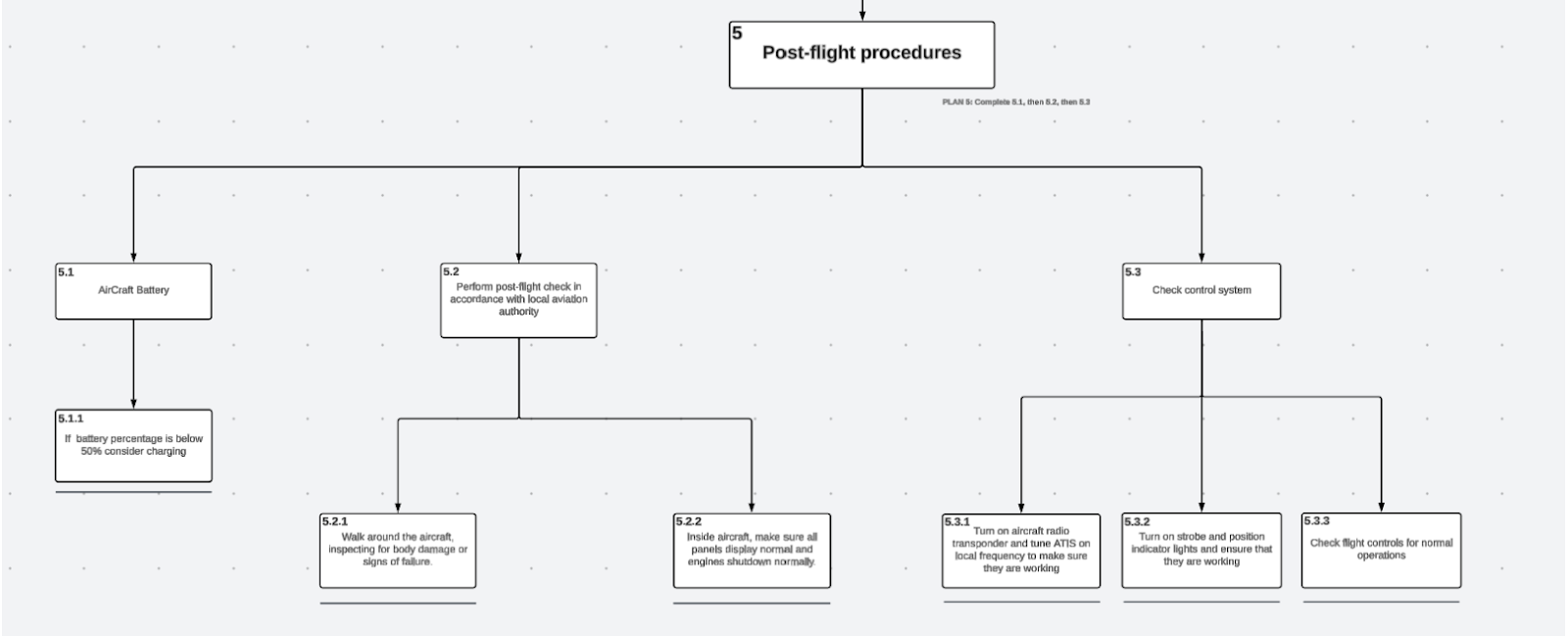
4.2 Model
The model of this aircraft was based on a few key design features. The goal was to maximize safety, comfort, and convenience for pilots and passengers alike. These design features allow this theoretical airframe to be used for the purposes outlined in this paper. Evaluation of the design needs of a specific business would be needed before similar vehicles could enter production.
This design features multiple rotors as opposed to the more common single-rotor design featured on most helicopters. The multiple rotors will provide redundant thrust sources, allowing for greater safety in the case of a failure (Carpenter Electrification, 2023). Safety is a major priority for any aircraft, especially those with passengers operating in constricted environments. Rennie (2022) states that multirotor craft have better control during flight, are more operationally efficient, and can fly closer to buildings, making them ideal for applications like eVTOLs. While this engine arrangement can reduce energy efficiency, the multirotor was in the end determined to be the safer option. Further research into the engine arrangement would be needed before the airframe could be certified or created.
The inclusion of solar panels on the aircraft was a decision made to offset some of the inherent inefficiency due to the engine arrangement. Airbus, a French aircraft corporation, has been working on lightweight solar cells that can provide a significant boost in the efficiency of an aircraft. Once these are made viable and available, eVTOL airframes would benefit from their implementation.
The relatively large size of the aircraft was chosen to accommodate all passengers. The height of the interior is about two meters, giving plenty of headroom for passengers of any mobility level. The maximum width of the interior is over three meters, giving space for passengers of varying size to fit comfortably into the aircraft. Choosing these dimensions also allows for the inclusion of a larger cargo hold to the rear. A drawing of this airframe is below. All units are in millimeters.

NOTE: This design was made within the Onshape computer assisted design program. This program is not usually used for modeling aircraft, but was chosen due to budget constraints. Nevertheless, this airframe is modeled as an example and works as a demonstration.
5. Discussion
5.1 Sound Concerns
Currently, transportation vehicles often use active noise control to reduce sound by introducing an equal but inverted soundwave to cancel out noise. Modern-day airplanes use “loudspeakers and microphones in the cabin” to cancel out sound. Because sound waves behave differently in different locations, global noise reduction is currently not possible for frequencies above 50 Hz. However, local noise cancellation (meaning active noise control in small areas) is possible by using microphones up to a frequency of 2000 Hz (Miller, Rossetti, and Norris, 1995). Any future eVTOL will likely have to use similar soundproofing techniques in the locations of the passenger and pilot.
Aerial taxis will also have external sound concerns relating to noise pollution. The World Health Organization (WHO) considers all noise above 65 dB as noise pollution, and planes today are still regularly louder than this, especially during takeoff. Noises louder than 45 dB can prevent proper sleep, and the WHO suggests that people should not be exposed to noises over 30 dB for optimal sleeping (Iberdrola). If an eVTOL service operates during the night the same way that many taxi services currently do, it will have to consider this in its soundproofing as well. The external engine noise of an airplane is correlated to jet speed, and turbofan engines, such as the GTF engine from Pratt & Whitney, can decrease noise footprint by up to 75% by decreasing jet speed, though these would not be viable for an aerial taxi service that operates 24/7 (Hansman and Thomas, 2020). Further technological developments relating to sound should therefore be a high priority in the creation of an aerial taxi service.
5.2 Design and Logistics
There are four main types of eVTOLs:
- The multicopter is said to be “very efficient during take-off, landing, and while hovering, but because they don’t have wings, they’re incredibly inefficient at going long distances. They could be useful in urban areas” (Kharpal, 2024).
- The lift and cruise “merges the multicopter with common aircraft technology, like wings, making longer distances possible”. However, the propeller would require fewer and shorter blades which makes it very noisy (Kharpal, 2024).
- The tiltrotor “has one or more rotors mounted on a wing that can tilt up and down” (Kharpal, 2024).
- The ducted vectored thrust uses “individually controlled electrical ducted fans to push the vehicle upward. This model is quieter and can fly longer distances efficiently, but [is] quite power-hungry” (Kharpal, 2024).
The use of eVTOLs is currently being discussed. Some consider them fit for urban use while others want them to help with transport between cities. Infrastructure that will be known as “vertiports” would have to be developed for eVTOLs to land safely.
There are currently a few notable companies that are developing different variants of the eVTOL. Lithium is based near Munich, Germany. They are working with the “ducted vectored thrust technology, with the company hoping its jets will be used for longer regional flights rather than urban routes”. Their jets are said to begin rolling out in 2026 with its main version estimated to sell for $9 million. They’ve currently accumulated quite a few investors, including Tencent (Kharpal, 2024).
Alef Aeronautics is developing “a vehicle that can drive on the road and fly in the air”. Notably, the car’s chassis is “hollow and hides several propellers”. They hope to start production at the end of 2025. People can put in a $150 deposit to pre-order the soon-to-be $300,000 vehicle (Kharpal, 2024).
Finally, EHang is a Chinese firm that will create “a passenger drone designed to fly around cities, with “several” propellers “extended on arms””. EHang’s EH26-S, their “flagship vehicle”, has a suggested retail price of $410,000 (Kharpal, 2024).
In terms of financial outlook, using an app can help reduce the number of employees required in a taxi business, and, as such, reduce costs. Although creating the app could be quite expensive at first, in the long run, a successful taxi business will end up saving. Due to our taxis being aerial, insurance costs may be relatively high, but these may be cut by finding the best alternatives. Social media marketing can help raise awareness, important when in competition with larger firms. It is also much cheaper than other forms of marketing, such as billboards. Travel limits could be put in place or price increases could be set above a certain distance traveled. This helps to cover costs that would be paid on fuel, especially when traveling longer distances. Finally, drivers should be monitored to ensure they are taking the shortest routes possible to conserve fuel. Any personal driving they do with the taxi should not affect the business and the drivers may be charged for wasting more fuel (Iceni Magazine, 2020).
To determine the speed requirements of eVTOLs, we must first consider their use cases. There is the obvious aerial taxi, but eVTOLs have many other uses such as for medical transportation, goods delivery, and cross-city transport. Therefore, when finding the optimal speed for these vehicles, it is important to take all these factors into account. We can start with taxi speeds in areas within the UK. There, they must follow the speed limits for all cars — 30 mph in “built-up areas” in England, Scotland and Northern Ireland (or 20 mph in Wales), 60 mph on single carriageways, and 70 mph on dual carriageways and motorways (GOV.UK).
However, medical transport vehicles are not required to abide by such speed limits when there is an emergency. While there is no limit for ambulances responding to a medical emergency in the UK, they are required to drive safely and reasonably, complying with the Road Travel Act. They must balance the urgency of the response with the need to remain safe on the road. However, the maximum speed a typical ambulance was expected to travel in areas of the UK is between 100 and 120 mph. Therefore, medical eVTOLs should be able to fly at those speeds (GOV.UK).
As for goods delivery, they must abide by the regular speed limits (restricted to 50 mph on single and dual carriageways) if the vehicle is not more than 7.5 tons laden weight — if they are over this weight, they are restricted to 60 mph on motorways (GOV.UK).
For cross-city transport, eVOTLs could follow the same speed limits for cars as mentioned above or, due to their flight capabilities, fly at speeds closer to those of trains. While trains in the UK aren’t known for their speed, in other parts of the world such as China, Germany, and France, trains have much higher speed capabilities. For example, the Shanghai Maglev in China has an average speed of around 285 mph. With the potential of eVOTLs, UK transport could achieve speeds close to these too without having to build the expensive infrastructure used for trains (Nilson, 2023). The “World’s Fastest eVTOL” was revealed last year on February 21, 2023. The Airspeeder Mk4 (crewed version) by Alauda Aeronautics can fly as fast as 225 mph, showing the potential for air travel in the future (Verdon, 2023).
According to an article on KDC, a NASA research paper suggests that aviation accidents range from 0.16 to 0.42 accidents per 100,000 hours of flight time, which is considerably safer than the automotive rate. The safety concerns for most eVTOLs include the powertrain, flight control, and weather conditions. To address these concerns, different methods must be employed. For instance, weather conditions are a significant factor. Current eVTOL designs are affected by changes in temperature (cold temperatures reduce battery efficiency) and high wind speeds. Overcoming this challenge in the short term could involve restricting eVTOL operations to environments with more stable weather conditions. The article also highlights the importance of high-level path mapping, especially in cities where autonomous aerial vehicles are used, to prevent collisions. Another issue is flying at lower altitudes, which increases the likelihood of bird strikes compared to traditional aircraft. Such impacts could cause severe damage, so ensuring that the critical components (e.g. the propellers) are protected would be a practical measure. Additionally, obtaining safety regulations is a challenge as regulation tends to move much slower than the technology it aims to regulate (Randall, 2024).
An article from STG Aerospace considers passenger safety concerning evacuation and lighting of the aircraft. The article notes that eVTOL aircraft cannot be directly compared to rotorcraft due to their innovative designs, which may result in different evacuation procedures. The possibility of fully autonomous flying taxis in the future also needs to be considered as eVTOLs become more prevalent. True autonomous aircraft will require entirely new approaches to emergency procedures and will have different lighting needs to assist passengers who might be disoriented during an evacuation. Thus, safety measures tailored specifically for eVTOLs must be developed to ensure safe and comfortable travel for all passengers. Cabin lighting, for example, will need to create a comfortable environment while also facilitating effective evacuation in emergencies (STG Aerospace, 2024).
As aerial taxis and eVOTLs lie in a gray area between cars and other aerial vehicles, such as airplanes, it’s worth seeing how those reduce weight. According to an article by Knauf Industries, “reducing the weight of a vehicle is a key aspect that affects its performance, driving economy and overall safety”. Methods that they discuss are listed below:
- Automotive parts using EPP and EPS could be used instead of other materials. These are types of plastics that are very lightweight but have very high strength, giving them great strength-to-weight ratios. They are also good at absorbing shock from impacts, making them an incredibly safe material to use.
- Other equipment and accessories for the car could be removed entirely, saving more weight, including rear seats and the tailgate (which could be replaced by an openable window).
- Other metals like aluminum can be used in place of steel, which would save weight on the car body (Knauf Automotive, 2024).
As for airplanes, the Sydney Morning Herald describes how they reduce weight to save fuel in many interesting and incredible ways. For instance, Virgin Atlantic uses thinner glassware and removes heavy slate plates. They even changed food items like chocolates for lighter alternatives along with redesigning the trays used to conserve storage space. According to one article, “the airline has estimated that losing a pound (0.45 kg) in weight from every plane in its fleet would save 53,000 liters of fuel a year, adding up to tens of thousands of dollars”. Qantas lost weight in “crockery, glassware, cutlery, and linen”, with 11% weight reduction. Additionally, their trolley carts went from 25 kg each to 18 kg. All of this will cause an estimated saving of 535,000 kg on fuel. Other methods of flight reduction include things as little as reducing the weight of magazines and papers on board. In terms of the aircraft themselves, it mentioned that “new lighter, more fuel-efficient aircraft produced by Boeing and Airbus, such as the 787 and the A350, where electrics replace heavy, mechanic systems, have led to large cuts in fuel bills” (Morris, 2018). Therefore, any strategy, no matter how small, can help contribute to weight reductions in aerial vehicles like the eVTOLs that will be used for aerial taxis.
Typical energy requirements for vertical flight can range between one and three kWh per minute, depending on the size and weight of the eVTOL. In horizontal flight, the energy requirement is usually much lower, as the aircraft is supported by the lift, which comes from the shape of the aircraft (this will be further emphasized if the eVTOL has some variant of fixed wing or airfoils positioned on the aircraft) (CNBC, 2024). To fit these requirements, one study has shown that “eVTOLs typically use lithium-ion batteries for their energy storage needs. Lithium-ion batteries are favored for eVTOLs due to their high energy density, which allows them to store a large amount of energy in a relatively lightweight package. This is important for eVTOLs, as they require a high energy density to achieve the range and performance necessary for practical use. Additionally, lithium-ion batteries are known for their high-power output, which is essential for the rapid acceleration and deceleration required in eVTOL flight” (Grepow, 2024).
Four main factors contribute to choosing an eVTOL’s battery:
1. Battery Chemistry. Lithium-ion batteries are the most common choice for eVTOLs due to their high energy density and power output. Other emerging battery chemistries, such as solid-state batteries, may also be suitable for eVTOL applications as they offer advantages in terms of safety and energy density (IBA Aero, 2024).
2. Voltage. The voltage of eVTOL batteries can vary depending on the design of the aircraft and the configuration of the battery system. However, most eVTOL batteries operate at voltages ranging from 400 to 800 volts to provide the necessary power for the electric motors (Axial, 2024).
3. Capacity. The capacity of eVTOL batteries is typically measured in kilowatt-hours (kWh) and depends on the range and endurance requirements of the aircraft. Smaller eVTOLs designed for urban air mobility might have battery capacities of around 100-300 kWh, while larger eVTOLs designed for longer-range flights might have capacities of one MWh or more (KDC Resource, 2024).
4. Energy Density. High energy density is crucial for eVTOL batteries to maximize the aircraft’s range and performance. Batteries with energy densities of at least 200 Wh/kg (watt-hours per kilogram) are generally recommended for eVTOL applications (Aerospace America, 2024).
In conclusion, lithium-ion batteries are currently the most viable option for eVTOL applications, balancing energy density, power output, and capacity to meet the varying requirements of different eVTOL designs. However, staying informed about advancements in solid-state batteries is advisable, as they could become a competitive alternative in the future (Amplyfi, 2023).
Many companies have researched the opportunities of aircraft with lightweight, high efficiency solar panels. However, two stand out as the most promising: EconCore and Solarge have “intensively collaborated” to develop a “next-generation” solar panel, which removes weight by replacing heavy glass with lightweight honeycomb materials, resulting in a “fully recyclable alternative to more traditional non-sustainable materials”. A new EconCore/Solarge panel that measures just over 2.66 m² weighs 14.5 kg, compared to more than 28 kg with the old glass-type model (KDC Resource, 2024).
However, as promising as this research is, one of the biggest concerns with eVTOLs is the source of their energy. We can only consider them fully green if this energy comes from renewable sources. However, solar panels on the aircraft might not be the answer, at least not currently. The biggest issue is the eVTOL’s design, as while solar panels might fit on something like the Lilium Jet, there is “nowhere for them on a design like the Volocopter”, as the aircraft must have wings to have the “required surface area” (NASA, 2024).
One possible solution to this is to pair with large solar farm companies to charge the vehicle on the ground, therefore allowing the eVTOL to be eco-friendly. Additionally, the infrastructure required to land the eVTOLs — hangars, maintenance shops, tool sheds, and all other related buildings — could be covered in solar panels, reducing energy expenses and lessening reliance on grid electricity (Designboom, 2024).
The main groups of materials used in aircraft construction nowadays are steel, aluminum alloys, titanium alloys, and fiber-reinforced composites. Titanium alloys possess high specific qualities, a good ratio of tensile strength to fatigue strength, a high fatigue limit, and the ability of some of them to maintain significant strength at temperatures as high as 400–500°C (Arnedo, 2021).
5.3 User Accessibility
Aerial taxis, like all flying vehicles, require weight limits to ensure fuel-efficiency and optimal speeds. Therefore, it is required to research the maximum weight of users and their luggage on these aerial vehicles. A Forbes article shows the findings of a European Union Aviation Safety Agency (EASA) study where they weighed passengers aboard aircraft along with their luggage to determine that “the average weight of passengers was 75.6 kg (166.7 lbs), and the average carry-on luggage weight was 7.6 kg (16.8 lbs).” Men’s carry-on luggage averaged 7.8 kg (17.2 lbs), resulting in a total weight (passenger plus luggage) of 90 kg (198.4 lbs), while women’s carry-on luggage averaged 7.5 kg (16.5 lbs), leading to a total weight of 75 kg (165.3 lbs). Therefore, to ensure inclusivity for all riders of aerial taxis, we must take these readings into account. Assuming that the aerial taxi can carry the driver plus two people with luggage, it would need to be able to lift roughly 75.6 + 90 + 90 = 255.6 kg. This fits well into the general specifications of similar vehicles like helicopters so it can be assumed that the maximum weight that eVOTLs will be able to carry is much greater than what will generally be required (Garcia, 2024).
Comfort is a critical consideration for eVTOLs, especially as these vehicles are intended for urban air mobility and other short-to-medium distance travel. There are two main types of comfort in vehicles:
1. Ride Comfort, which refers to how smooth and stable the journey feels to the passengers. In eVTOLs, several factors contribute to this, including the suspension system, vibration damping, noise levels, and the aircraft’s ability to handle turbulence. EVTOL manufacturers focus on minimizing vibrations and optimizing noise levels through both active and passive noise control technologies (Parker, 2024). Active noise control systems use sensors to detect unwanted noise frequencies and generate counter-sound waves to cancel them out, improving the overall acoustic experience for passengers. In addition to vibration and noise management, ride comfort also relies heavily on the eVTOL’s flight stability, which is maintained through advanced avionics and autonomous flight systems (STG Aerospace, 2024). These systems continuously adjust the aircraft’s position and speed, ensuring a smooth flight even during unexpected weather conditions or air traffic disturbances.
2. Creature Comforts refer to features that enhance the passenger’s overall experience within the cabin, such as climate control, ergonomic seating, lighting, and in-flight entertainment options. For example, the development of personalized air-conditioned seating systems ensures that each passenger can maintain their preferred temperature level (ResearchGate, 2024). These systems reduce energy consumption by cooling the area immediately surrounding the passenger rather than the entire cabin. Seats in eVTOLs are also being designed for maximum comfort while conserving space and weight. Innovations include adjustable headrests to prevent whiplash and extra padding for extended trips, ensuring that passengers remain comfortable throughout the journey (Ergonomics4Schools, 2024). Additional features like integrated charging ports, cup holders, and compatibility with smart device systems, like Apple CarPlay or Android Auto, also add to the convenience and comfort of the passenger experience.
Two possible luggage loads could be facilitated by the varying sizes of aircraft. Judging by the smaller size, an eVTOL would have a relative interior size similar to a Robinson R-44, where only hand luggage would be transportable, around 12 kg maximum per passenger (OrbicAir, 2024). For larger-scale aircraft, the general correlation between lifting power and weight would allow for each adult and child passenger to have a 20 kg luggage allowance, with bags not exceeding 70 x 39 x 31 cm (Arab News, 2024).
The middle seats of an aerial taxi can generally be reduced by 20 mm on each side at the shoulders, allowing for more efficient use of space. Dimensions for the seats should be as seen in figure 20b. Rows 1, 2, and 3 on both the 6-rotor aircraft and row 1 and 2 on the 4-rotor aircraft are outlined (CNBC, 2024). Headrests or restraints should be a minimum of 200 mm if they are not adjustable, to prevent whiplash in the case of sudden deceleration. Assuming that the aircraft would have a back wall on the headrests, this would allow for greater cargo storage (Arab News, 2024).
5.4 Operational Concerns
In terms of demand for flying taxis, there are pretty good-looking prospects. According to Janet Bernard, “the increasing population will result in traffic conjunction in many nations. Flying taxis are the latest technological innovation in the automotive industry to overcome these problems” (Bernard, 2023).
To limit the use of electricity in eVTOLs, research should be done into the ways this is carried out in both cars and planes (although planes normally rely on fuel rather than electricity). Starting with cars, the best methods for users to limit their use of electricity seem to be accelerating more slowly, staying at a constant speed as long as possible by reading the road and accelerating or decelerating slowly too, not going at overly high speeds, slowing down as much as possible without breaks, turning off the vehicle when paused for over a minute, removing excess weight, and using less air conditioning (Government of Canada).
In terms of planes, the Continuous Descent Approach (CDA) has gained traction due to its benefits for energy conservation. Unlike the traditional approach where aircraft descend in multiple stages, CDA allows for a smooth and uninterrupted descent. This approach helps in lowering both fuel usage and emissions. Another effective practice is single-engine taxiing. Typically, aircraft use both engines while taxiing on the ground, but by employing only one engine, airlines can achieve a significant reduction in fuel consumption and emissions, ranging from 20% to 40%.
Airlines are actively exploring various strategies to improve their fuel and energy efficiency. For instance, British Airways is investing in zero-emission aircraft like those from ZeroAvia to cut down on their carbon emissions. Similarly, Emirates is working on lowering its environmental impact by integrating electric aircraft, adopting green standard operating procedures, and utilizing sustainable aviation fuels (SAFs) (Amplyfi, Jul 28, 2023).
Using some of these methods from both planes and cars, eVTOLs will have a better chance of reducing electricity consumption which would save on costs as well as decrease their environmental impact.
5.5 Public Opinion
There are varying views when it comes to accepting aerial taxis and eVTOLs. On one end of the spectrum, there are those who are enthusiastic to see the beneficial impacts that aerial taxis will have on urban transportation (Robinson, 2024). With their ability to easily pass by city traffic in highly populated areas, they can make tasks like driving to work far less time consuming. Additionally, with more people in the air rather than on the ground, traffic congestion can be greatly reduced too (Debusmann Jr., 2021). On the other hand, many people consider aerial taxis and eVTOLs to have too many risks and issues associated with them. For example, one of the main problems is safety, as proper measures must be put in place to ensure reliable flights with no danger to passengers or civilians traveling below (Robinson, 2024). Furthermore, noise generated by these vehicles is another concern, as urban environments can be affected by the loud propellers of the eVTOLs (Rahman-Jones, 2024). Moreover, manufacturers must ensure that the energy sources of aerial taxis and eVTOLs are energy efficient and sustainable. Charging stations known as “sports” still need to be developed which would also cause sustainability concerns (Rahman-Jones, 2024; Robinson, 2024). Therefore, these areas must be covered by all eVTOL and aerial taxi manufacturers in order to assure people that they would provide benefits rather than extra problems in our domestic environments.
6. Limitations
We have considered many limitations to this study. Firstly, all the research that our team studied was based on a theoretical literature review. We tried to collect research articles that had experimented with aerial transportation, but due to the lack of any literature review, we were unable to do so. Instead, our team analyzed transportation that was similar to EV tolls such as cars and airplanes. Because of this, there may be concerns about the applicability of our model in practical situations. Secondly, the models that our team created were mainly prototypes based on research. These prototypes weren’t subject to any kind of testing. Therefore, it is yet to be determined if the prototypes that we have developed are successful. Lastly, the designs that our team had created were not tailored to various international laws and regulations. Our model didn’t consider multiple countries’ aerial traffic control rules, instead focusing on UK regulations. These are the factors that are considered to be limitations of our study.
7. Conclusions
The aerial taxi market is anticipated to grow by 46% from 2022 to 2024 (Alnuaimi, 2021). In response to this growing interest, this research seeks to evaluate the future of eVTOL taxis from a human-centered design perspective. Specifically, it focuses on designing HTAs that reflect the needs and perspectives of both users and pilots of potential eVTOL taxi services. In addition to this, the study examines current technologies from various transportation fields, identifying those relevant to the advancement of eVTOL taxis. By integrating this research with HTAs, the study aims to pinpoint key development issues — ensuring future eVTOL models are designed with comfort, safety, and performance in mind, positioning them as competitive solutions for both the 21st and 22nd centuries. Furthermore, this research delves into current and potential future technologies, addressing critical challenges and proposing solutions that will advance the field. A conceptual model of a future eVTOL taxi is developed, serving as a reference for future innovations. The findings and insights are poised to be valuable for future engineers, offering comprehensive solutions that consider both user and pilot experiences. Despite the limitations of the study, it concludes that eVTOL taxis have the potential to revolutionize the future of transportation.
Bibliography
ACS Publications Chemistry Blog. (2024). The Future of Flight: A Look Into eVTOL Battery Technology. [online] Available at: https://axial.acs.org/energy/the-future-of-flight-a-look-into-eVTOL-battery-technology [Accessed 20 Aug. 2024].
Aerospace America. (2024). A charging network for air taxis begins to take shape in U.S. [online] Available at: https://aerospaceamerica.aiaa.org/a-charging-network-for-air-taxis-begins-to-take-shape-in-u-s/ [Accessed 20 Aug. 2024].
Airbus. (2021, July 1). https://www.airbus.com/en/innovation/energy-transition/solar-flight
Alnuaimi, Maitha Ali Salem. (2021). Aerial planning for flying Taxi of Dubai. [online] Available at: https://repository.rit.edu/cgi/viewcontent.cgi?article=12115&context=theses [Accessed 2 Sep. 2024].
AMPLYFI (2023). Energy Efficiency and Air Transport – AMPLYFI. [online] AMPLYFI. Available at: https://amplyfi.com/2023/07/28/energy-efficiency-and-air-transport/#:~:text=Single%2DEngine%20Taxiing [Accessed 25 Aug. 2024].
Answerbase.com. (2021). How many passengers and luggage can fit per trip? (Helicopter Burbank to Las Vegas). [online] Available at: https://orbicair.answerbase.com/3794485/How-many-passengers-and-luggage can-fit-per-trip [Accessed 6 Sep. 2024].
Arnedo, M.S. (2021). 4.2.2: Materials in aircraft. [online] Engineering LibreTexts. Available at: https://eng.libretexts.org/Bookshelves/Aerospace_Engineering/Fundamentals_of_Aerospace_Engineering_(Arn edo)/04%3A_Aircraft_structures/4.02%3A_Materials/4.2.02%3A_Materials_in_aircraft [Accessed 24 Aug. 2024].
Bernard, J. (2023). The global flying taxis market size accounted for USD 2.94 billion in 2022 and is expanding by around USD 37. [online] Linkedin.com. Available at: https://www.linkedin.com/pulse/flying-taxis-market demand-future-scope-next-10-years-janet-bernard/ [Accessed 19 Aug. 2024].
Canada, (2018). Fuel-efficient driving techniques. [online] natural-resources.canada.ca. Available at: https://natural-resources.canada.ca/energy-efficiency/transportation-alternative-fuels/personal-vehicles/fuel efficient-driving-techniques/21038 [Accessed 25 Aug. 2024].
CDC (2018). CDC – Aircrew Safety and Health – Noise/Hearing Loss – NIOSH Workplace Safety & Health Topics. [online] Available at: https://www.cdc.gov/niosh/topics/aircrew/noise.html [Accessed 21 Aug. 2024].
Chang, T.-B. and Chen, R.-H. . A low energy consumption air-condition system for light electric vehicle. [online] Available at: https://www.researchgate.net/publication/289775347_A_low_energy_consumption_air condition_system_for_light_electric_vehicle [Accessed 19 Aug. 2024].
Compton, N.B. (2019). The completely correct guide to getting off a plane. Washington Post. [online] 17 Sep. Available at: https://www.washingtonpost.com/travel/tips/completely-correct-guide-getting-off-plane/ [Accessed 24 Aug. 2024].
Debusmann Jr, B. (2021). You may be able to book a flying taxi within three years. BBC News. [online] 17 Oct. Available at: https://www.bbc.com/news/business-58895259 [Accessed 4 Sep. 2024].
DesignBoom (2024). NASA backs solar-powered eVTOL that can explore the entire surface of mars. [online] designboom | architecture & design magazine. Available at: https://www.designboom.com/technology/nasa maggie-solar-powered-eVTOL-coflow-jet-niac-01-15- 2024/#:~:text=Looking%20at%20its%20design%2C%20the [Accessed 20 Aug. 2024].
Ergonomics4schools.com. (2019). ergonomics4schools – seating. [online] Available at: https://www.ergonomics4schools.com/lzone/seating.htm [Accessed 18 Aug. 2024].
EVTOL 101: Benefits of Electric Aircrafts. Carpenter Electrification. (2023, March 7). https://www.carpenterelectrification.com/blog/benefits-electric -aircrafts#:~:text=Safety%3A%20eVTOL%20aircraft%20can%20be,a%204%20passenger%20air%20taxi.Solar flight.
Garcia, M. (2024). Despite Backlash, Here’s Why Airlines Need To Weigh Passengers. Forbes. [online] 20 Feb. Available at: https://www.forbes.com/sites/marisagarcia/2024/02/11/despite-backlash-heres-why-airlines-need to-weigh-passengers/ [Accessed Aug 23. 2024].
Gbtrnd.com. (2024). EHang and Greater Bay Technology Develop World’s First Ultra-Fast Charging Batteries for eVTOL-GBT. [online] Available at: https://eng.gbtrnd.com/portal/article/index.html?id=27 [Accessed 20 Aug. 2024].
Government Digital Service (2011). Speed limits. [online] GOV.UK. Available at: https://www.gov.uk/speed limits [Accessed 21 Aug. 2024].
Grepow.com. (2024). What Is An eVTOL And How To Choose Batteries For It? | Grepow. [online] Available at: https://www.grepow.com/blog/what-is-an-eVTOL-and-how-to-choose-batteries-for-it.html [Accessed 20 Aug. 2024].
Hansman, R.J. and Thomas, J. (2020). Evaluation of the Impact of Transport Jet Aircraft Approach and Departure Speed on Community Noise . MIT International Center for Air Transportation. [online] Available at: https://s3.wp.wsu.edu/uploads/sites/2479/2020/07/Aircraft-Speed-Impacts-on-Community-Noise-Report Final_v13.pdf [Accessed 21 Aug. 2024].
IBA. What Does the Future of eVTOL Battery Technology Look Like? [online] Available at: https://www.iba.aero/insight/the-future-of-eVTOL-battery-technology/ [Accessed 20 Aug. 2024].
Iberdrola. Noise pollution: how to reduce the impact of an invisible threat? [online] Available at: https://www.iberdrola.com/sustainability/what-is-noise-pollution-causes-effects-solutions#:~:text=Not%20all%20sound%20is%20considered [Accessed 21 Aug. 2024].
Iceni Magazine. (2020). How to Cut Costs in Your Taxi Business. [online] Available at: https://www.icenimagazine.co.uk/how-to-cut-costs-in-your-taxi-business/ [Accessed 20 Aug. 2024].
KDC Resource (2021). Are Solar Powered Aircraft the Answer to eVTOLs’ Sustainability Questions? [online] KDC Resource. Available at: https://www.kdcresource.com/insights-events/are-solar-powered-aircraft-the answer-to-eVTOLs-sustainability-questions/ [Accessed 20 Aug. 2024].
KDC Resource (2024). Safety First Process in eVTOL Design | KDC Resource. [online] KDC Resource. Available at: https://www.kdcresource.com/insights-events/safety-first-process-in-eVTOL design/#:~:text=There%20are%20three%20main%20areas [Accessed 21 Aug. 2024].
Kennedy Martinez The History Of Drones (Drone History Timeline From 1849 To 2019). [online] Dronethusiast. Available at: https://www.dronethusiast.com/history-of-drones/ [Accessed 4 Sep. 2024].
Kharpal, A. (2024). Inside the world of flying cars, or eVTOLs, which are moving closer to reality. [online] CNBC. Available at: https://www.cnbc.com/2024/04/19/what-is-an-eVTOL-how-flying-cars-are-moving-closer-to reality.html [Accessed 19 Aug. 2024].
Knauf Industries Automotive. (2024). Vehicle weight reduction: methods and materials | Knauf. [online] Available at: https://knaufautomotive.com/news/car-equipment-and-construction/weight-reduction/ [Accessed 22 Aug. 2024].
Kovacevic, S., Vučinić, J., Kirin, S. and Pejnović, N. (2010). Impact of anthropometric measurements on ergonomic driver posture and safety. Periodicum Biologorum. [online] Available at: https://www.researchgate.net/publication/279506800_Impact_of_anthropometric_measurements_on_ergonomic _driver_posture_and_safety [Accessed 18 Aug. 2024].
Makkah (2024). Saudi Arabia inaugurates self-driving aerial taxi during Hajj. [online] Arab News. Available at: https://www.arabnews.com/node/2528991/saudi-arabia [Accessed 6 Sep. 2024].
Martin, C. (2024). Flying Taxi Company Partners for Extreme Fast Battery Charging. [online] IOT World Today. Available at: https://www.iotworldtoday.com/flying-vehicles/flying-taxi-company-partners-for-extreme-fast battery-charging [Accessed 20 Aug. 2024].
Mayhew, N.. Training fact sheet – visibility. Vertical Aviation Safety Team. https://vast.aero/archives/Safety_Bulletins/Visibility.pdf.
Miller, L.R., Rossetti, D.J. and Norris, M.A. (1995). Passive, Active, and Hybrid Solutions for Aircraft Interior Noise Problems. [online] Available at: https://www.parker.com/Literature/Assembly%20&%20Protection%20Solutions%20Division/Whitepapers/Whi te%20Paper%20-%20Passive,%20Active,%20and%20Hybrid%20Solutions%20for%20Aircraft%20Interior%20 Noise%20Problems%20LL6007.pdf [Accessed 19 Aug. 2024].
Morris, H. (2018). Airline weight reduction to save fuel: The crazy ways airlines save weight on planes. [online] The Sydney Morning Herald. Available at: https://www.smh.com.au/traveller/reviews-and-advice/airline-weight reduction-to-save-fuel-the-crazy-ways-airlines-save-weight-on-planes-20180903-h14vlh.html [Accessed 22 Aug. 2024].
Nilson, P. (2023). The 10 fastest high-speed trains in the world. Railway Technology. [online] 5 Jun. Available at: https://www.railway-technology.com/features/the-10-fastest-high-speed-trains-in-the-world/ [Accessed 21 Aug. 2024].
O’Donoghue, J., (2023). A Simple Guide to Hierarchical Task Analysis – Make:Iterate. [online] Available at: https://makeiterate.com/a-simple-guide-to-hierarchical-task-analysis/ [Accessed 31 Aug. 2024].
Peng, J., Wang, X. and Denninger, L. (2017). Effects of Anthropometric Variables and Seat Height on Automobile Drivers’ Preferred Posture With the Presence of the Clutch. Human Factors: The Journal of the Human Factors and Ergonomics Society, [online] 60(2), pp.172–190. doi:https://doi.org/10.1177/0018720817741040.
Petzäll, J. (2000). The design of entrances of taxis for elderly and disabled passengers: An experimental study. Elsevier, [online] 26(5), pp.343–352. Available at: https://www.sciencedirect.com/science/article/abs/pii/0003687095000518 [Accessed 18 Aug. 2024].
Rennie, J. (2022, May 9). Drone types: Multi-rotor, fixed-wing, single rotor, hybrid vtol. AUAV. https://www.auav.com.au/articles/drone-types/#:~:text=A%20single%2Drotor%20helicopter%20has,a%20propeller%2C%20giving%20great%20efficiency.
Rahman-Jones, I. (2024). Government wants flying taxis to take off in 2 years. [online] BBC. Available at: https://www.bbc.com/news/technology-68597045 [Accessed 4 Sep. 2024].
Robinson, T. (2024). Will the ‘aerial taxis’ of the future be safe? [online] Royal Aeronautical Society. Available at: https://www.aerosociety.com/news/will-the-aerial-taxis-of-the-future-be-safe/ [Accessed 4 Sep. 2024].
Stgaerospace.com. (2024). Considering passenger safety for eVTOL aircraft | STG Aerospace. [online] Available at: https://www.stgaerospace.com/newsroom/considering-passenger-safety-eVTOL-aircraft [Accessed 21 Aug. 2024].
U.S. Department of Transportation (2022). Climate Action | US Department of Transportation. [online]www.transportation.gov. Available at: https://www.transportation.gov/priorities/climate-and sustainability/climate-action. [Accessed 2 Sep. 2024].
Verdon, M. (2023). Meet the World’s Fastest eVTOL, Alauda’s Airspeeder MK4. [online] Robb Report. Available at: https://robbreport.com/motors/aviation/airspeeder-worlds-fastest-eVTOL-arrived-1234809985/ [Accessed 21 Aug. 2024].
Visibility | SKYbrary Aviation Safety. SKYbrary Aviation Safety. (n.d.). https://skybrary.aero/articles/visibility#:~:text=Visibility%20is%20an%20important%20factor,landing%2C%20 and%20taxi%2Din.




